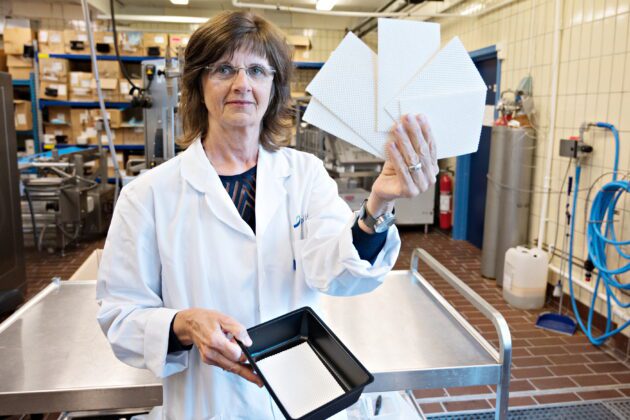Greener food packaging with wood fibre from Norwegian forest

Research at RISE PFI and Nofima has helped develop new and greener liquid absorbents for food packaging. The new absorbents are made from raw materials from Norwegian forests and can be found under fresh foods in the future.
Food packaging is complex. The packaging shall ensure the quality and shelf life of the food throughout the value chain.

The use of complex materials in packaging has increased, and waste has increased by about 30 percent over the past 10 years.
Fibre from trees replaces petroleum raw materials
All fresh food products, such as meat and fish, release some liquid during their shelf life. Absorbent mats are used in the packaging to collect this liquid. The task of an absorption mat is to collect residual liquid from the food so that it stays fresh and of good quality for as long as possible. The better the packaging, the less food waste.
The majority of such absorbent mats on the market today contain synthetic, fossil-based absorbent polymers and fossil-based plastics with a relatively high environmental footprint. Consumers in both Norway and the rest of Europe are now making more stringent environmental and sustainability demands on manufacturers. A significant increase is thus expected in the market for food packaging from renewable resources, and a shift from plastic to paper and cellulose in the future.
Have rated the quality of food – As good as existing products
Nofima’s role in the project has been to evaluate food quality and food safety when using packaging with the new type of EcoSorb liquid absorbent.
“We know that absorbents used today are safe and give food good shelf life. That is why we have monitored the food quality during the development of the new absorbent. Among other things, we have tested absorbents of different sizes, looked at the fluid loss from different fish and meat products and assessed food quality in general during the project,” says researcher Julie Nilsen-Nygaard at Nofima,
Julie and her colleagues have conducted microbiological tests to look at the development of bacteria with the new absorbent and sensory tests at Nofima’s sensory panel. They found no significant differences in either appearance or taste when using the cellulose absorbents. There are also no signs of harmful bacterial development, and the shelf life of the products is unchanged. The food is packed both in a vacuum and in a modified atmosphere.
“We have seen that the foods we tested do not lose quality with the new absorbent. It works just as well as existing products that are based on fossil raw materials,” says Nilsen-Nygaard.
The absorption mats are not yet on the market, but mass testing of the fibres is currently underway at a German manufacturer of liquid absorbers. If the tests are successful, the hope is that the mats can reach a large market throughout Europe.
Innovation project with interdisciplinary network building and skills development
The research institute RISE PFI in Trondheim initiated an innovation project in collaboration with fibre producer MM Karton FollaCell AS and the absorbent producer Mc Airlaid’́s Vliesstoffe GmbH, with the aim of developing a new type of greener, bio-based liquid absorbent based on 100% lignocellulose fibre from Norwegian trees.
Nofima, Nortura, SalMar and Bewi/Tommen Gram were also included in the project in order to ensure that the newly developed products would be safe in contact with food, that consumer health and product quality are safeguarded, and to develop comprehensive environmentally friendly, functional and profitable packaging solutions. The project group represented all parts of the value chain, from fibre producer, via the absorption mat manufacturer, to the packaging concept supplier and the end users. The project was carried out with financial support from the Research Council of Norway (RCN). It was in progress for four years and was completed in 2020.
Project manager Kathrin Mörseburg at RISE PFI AS emphasizes the constructive attitude of all the project partners:
“Among other things, joint meetings of the various project participants were a very successful strategy for networking and competence building, which was appreciated by all the project participants,” says Mörseburg.
The project has created new strategic national and international alliances and partners. Project owner Odd Morten Aalberg at MMK FollaCell points out the increase in expertise in the company as an important result of the project, as well as close customer collaboration for deliveries in the new market segment for absorption mats within one to two years.
Facts
EcoSorb, a project with the aim of developing, validating and commercializing a safe and effective liquid absorber, based on fibre from the Norwegian forest. The project will result in greater demand for raw materials from Norwegian forests and provide sustainable value creation in Norway, and less use of petroleum raw materials for food packaging.
The project is part-funded by the Research Council of Norway and is led by RISE PFI AS. The project owner is FollaCell AS. Partners are Mc Airlaids’s Vliesstoffe GmbH, Nortura SA, SalMar ASA, Nofima and Bewi AS.
Contact person
Topics
Packaging materials
Research facilities
